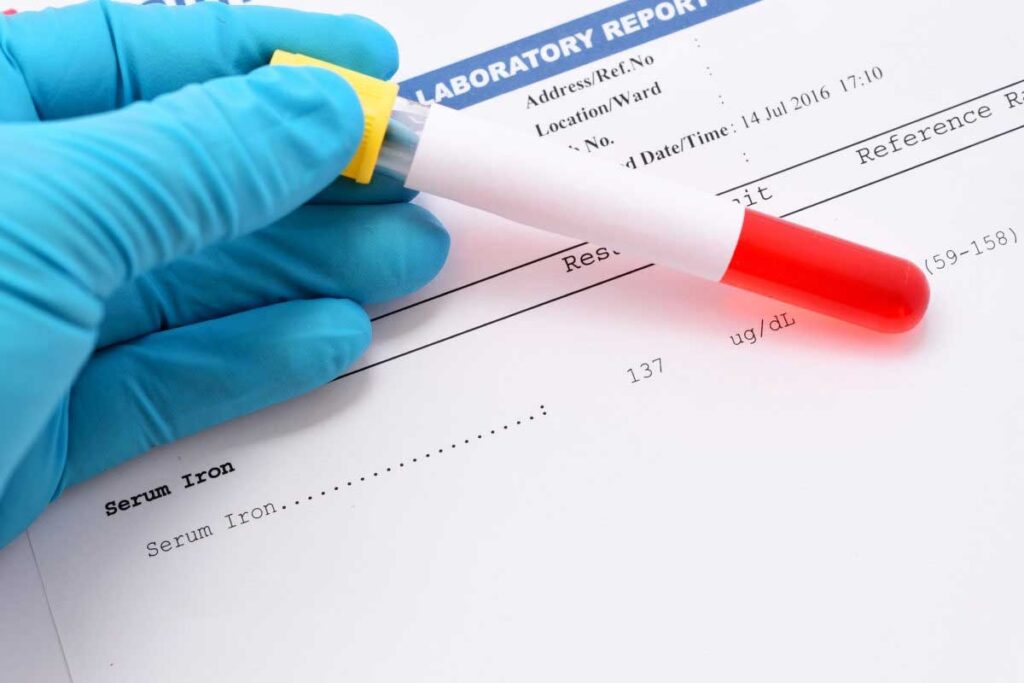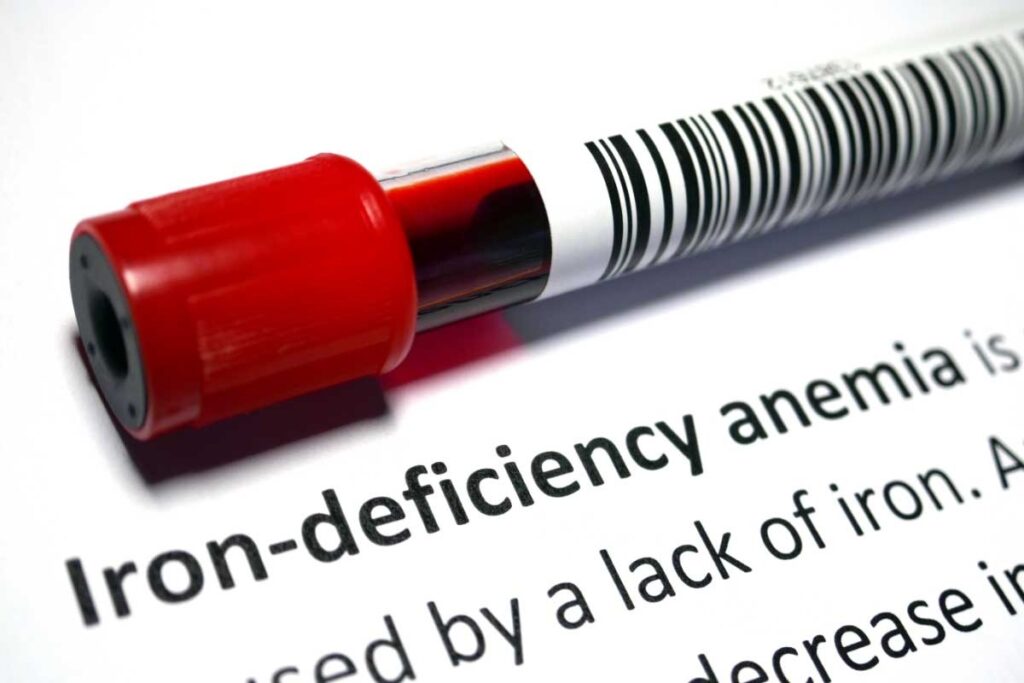
Iron deficiency anemia happens when the body doesn’t have enough healthy red blood cells. This leads to fatigue, weakness, and paleness. Sometimes, severe anemia can cause fever, mainly during infections or when the body fights off sickness.Is there a link between low iron and fever? Learn the crucial symptoms, risks, and positive treatment options explained simply.
At Liv Hospital, we know how important it is to catch and treat iron deficiency anemia early. Our team is dedicated to giving world-class healthcare. We also offer full support to patients from around the world.

Iron deficiency is a big health problem worldwide. It affects many groups, like pregnant women and kids. It can cause many health problems.
Iron is key to making hemoglobin, which carries oxygen. Without enough iron, the body’s tissues and organs can’t get the oxygen they need.
Iron is vital for energy and immune function. It’s a big part of hemoglobin. Without enough, you might feel tired, weak, and have trouble breathing. Knowing how iron works in our bodies helps us see how iron deficiency affects health.
Iron also helps the immune system work right. It helps make white blood cells, which fight infections. Not having enough iron can weaken the immune system, making it harder to fight off sickness.
Iron deficiency is a big problem everywhere, affecting millions. It’s one of the most common nutritional issues, with big health effects.
Some groups face a higher risk of iron deficiency. Pregnant women, kids, and people with chronic diseases are more likely to be affected. Spotting and treating iron deficiency early is key to avoiding serious health problems.
We need to tackle iron deficiency with a strong healthcare plan. This includes better diets and supplements. By understanding the dangers of iron deficiency, we can fight it better.

We are looking into how iron deficiency and fever are linked. This topic is very important in medical studies. The link between low iron and fever is complex, involving many body processes and serious health issues.
Studies show that severe anemia can cause fever, often during infections or when the body fights off diseases. People with iron deficiency anemia get sick more easily. This can lead to fever.
A study on the National Center for Biotechnology Information website found iron is key for our immune system. Without enough iron, we get sick more often.
More research is needed to understand how iron deficiency and fever are connected. But, studies are showing a strong link, mainly in people with anemia.
Iron is important for making hemoglobin, which carries oxygen. Without enough iron, our bodies can’t carry oxygen well. This makes us more likely to get sick and have fever.
Iron also helps our immune system work right. Without enough iron, our immune system can’t fight off infections as well. This means people with low iron might get fever more easily.
| Physiological Mechanism | Description | Impact on Fever |
| Impaired Oxygen Transport | Low iron levels reduce hemoglobin production, impairing oxygen transport to cells. | Increased susceptibility to infections, potentially leading to fever. |
| Immune System Dysfunction | Iron deficiency disrupts immune cell balance, impairing the body’s ability to fight off infections. | Increased risk of developing fever in response to infections. |
| Inflammation | Iron deficiency can lead to chronic inflammation, which may contribute to fever. | Potential cause of fever in individuals with low iron levels. |
It’s important to know about iron deficiency anemia to understand its health effects. This condition happens when the body has too little iron. This leads to less hemoglobin, making it hard to carry oxygen to tissues.
Iron deficiency anemia is when the body can’t make enough hemoglobin. This is because it lacks enough iron. Symptoms include feeling very tired, weak, and pale. You might also have trouble breathing.
To find out if you have it, doctors do blood tests. They check your hemoglobin and iron levels. The complete blood count (CBC) is a common test for this.
Iron deficiency goes through different stages:
It’s key to catch and treat iron deficiency anemia early.
“Iron deficiency anemia is a big health problem worldwide. We need to tackle it with diet changes, supplements, and finding the root causes.”
| Stage | Characteristics | Hemoglobin Levels |
| 1 | Depletion of iron stores | Normal |
| 2 | Iron-deficient erythropoiesis | Normal |
| 3 | Iron deficiency anemia | Below Normal |
Managing iron deficiency anemia needs a few steps. This includes changing your diet, taking iron supplements, and fixing the root causes.
Knowing about iron deficiency stages and symptoms helps get help early. Treating it right can make you feel better and improve your health.
It’s important to know the signs of iron deficiency early. This can help in getting the right treatment. Iron deficiency anemia can really affect how well you feel, so spotting the signs is key.
The main signs of iron deficiency are fatigue, weakness, and pale skin. These happen because your body doesn’t have enough iron. Iron is needed to make hemoglobin, which carries oxygen.
When iron deficiency gets worse, more serious symptoms can show up. These include shortness of breath, dizziness, and headaches. These signs mean you need to see a doctor.
| Symptom | Description |
| Shortness of Breath | Hard to breathe because of not enough oxygen |
| Dizziness | Feeling dizzy or off-balance from not enough oxygen to the brain |
| Headaches | Often having headaches or severe ones because of not enough oxygen |
Iron deficiency symptoms can differ by age. Children and adolescents might see signs that affect their growth. Pregnant women often face more severe symptoms because they need more iron.
It’s vital to consider these age-specific symptoms when diagnosing and treating. Knowing the specific signs in each age group helps doctors give better care.
Having enough iron is key for a strong immune system. Iron helps our body fight off infections. Without enough iron, our health can suffer greatly.
Iron is vital for immune cells like T lymphocytes and macrophages. These cells help us fight off germs. Iron also helps make reactive oxygen species that kill microbes. Having enough iron means our immune system can fight infections better.
Low iron makes it harder for our body to fight infections. People with iron deficiency anemia get sick more often. This is because their immune cells don’t work as well.
Iron deficiency and infections go hand in hand. Low iron can make us more likely to get sick. Getting sick can also make iron deficiency worse by causing inflammation and reducing iron absorption.
Inflammation is a natural response to injury or infection. But, it can also lead to iron deficiency. This is because inflammation increases hepcidin, a hormone that controls iron. High hepcidin levels mean less iron for our body to use.
It’s important to understand how iron, immune function, and inflammation are connected. This knowledge helps us find ways to prevent and treat infections in people with low iron.
Iron deficiency can make people more likely to get fever. This is because it weakens the immune system and makes infections more common. We’ll look into how low iron levels and fever are connected.
Low iron can cause the body to overreact to inflammation. This can lead to fever. Chronic inflammation also uses up more iron, making it harder to manage both issues.
People with iron deficiency anemia get sick more easily. Secondary infections can make them feverish. We’ll see how iron helps fight off infections and how a lack of it increases the risk.
Other things can also make people with low iron get fever. This includes changes in metabolism and stress responses. Knowing these triggers helps doctors treat both the fever and the iron deficiency better.
Looking into why fever happens in people with low iron helps us understand the link between iron, immune function, and how the body reacts to infections and inflammation. This is key for doctors to treat these conditions well.
It’s important to know who is at risk of iron deficiency. This condition can affect anyone. But, some groups are more likely to get it because of their health, diet, or other factors.
Young people grow fast and need a lot of iron. Their diets often don’t have enough iron. Early detection is key to stop health problems later on.
Pregnant women need more iron because of the growing baby. Women who menstruate also lose iron each month. Getting enough iron is essential for their health and the baby’s.
The elderly are at high risk too. This is because of poor diet, chronic diseases, and medicines that block iron absorption. Making sure they get enough iron can help prevent health problems.
People with chronic diseases like celiac or Crohn’s disease are more likely to lack iron. These diseases make it hard for the body to absorb iron. Treating the disease is important to avoid iron deficiency.
| High-Risk Group | Primary Risk Factors | Preventive Measures |
| Children and Adolescents | Rapid growth, inadequate diet | Iron-rich foods, regular check-ups |
| Pregnant and Menstruating Women | Increased iron demand, menstrual blood loss | Iron supplements, balanced diet |
| Elderly Population | Poor diet, chronic diseases, medication | Dietary adjustments, health monitoring |
| Individuals with Chronic Conditions | Impaired iron absorption | Managing underlying conditions, targeted supplementation |
To diagnose iron deficiency and fever, doctors use blood tests, clinical checks, and rule out other diseases. We’ll look at these steps to see how doctors find and treat iron deficiency anemia and fever.
Blood tests are key in finding iron deficiency anemia. Important markers include:
These tests confirm iron deficiency anemia, which can cause fever. A study on the National Center for Biotechnology Information website says accurate diagnosis is key for good treatment.
Doctors also evaluate patients clinically to diagnose iron deficiency and fever. They check:
A detailed clinical check helps doctors find the cause of fever and its link to iron deficiency.
Differential diagnosis is vital to exclude other diseases that might cause fever and anemia. Doctors consider:
By looking at these possible causes, doctors can accurately diagnose and treat fever and iron deficiency.
Managing low iron and fever needs a full plan. This includes changing what we eat, taking supplements, and fixing the root causes. We’ll look at ways to ease symptoms and boost health.
Changing our diet is key in fighting iron deficiency. Increasing iron intake with foods like red meat, beans, and fortified cereals helps. Foods high in vitamin C, like citrus fruits, also help iron absorption.
But, some foods like tea and coffee can block iron absorption. Avoiding or reducing these items helps iron absorption from iron-rich foods.
For some, just diet changes aren’t enough. Iron supplementation is then needed. There are many iron supplements, like ferrous sulfate, to choose from.
It’s important to get a doctor’s advice on iron supplements. This avoids over-supplementation and side effects. Regular iron level checks are also key to adjust the dosage.
Controlling fever is key when treating low iron and fever. Antipyretic medications like acetaminophen can help. But, always check with a doctor before using any medication, for kids or those with health issues.
Fixing the reasons for iron deficiency and fever is vital. This might mean looking into issues like bleeding, menstrual problems, or chronic diseases.
A good treatment plan is made just for you. It considers your health history, lifestyle, and diet. By tackling the causes and using the right diet and supplements, we can manage low iron and fever well.
Iron deficiency can cause many health problems. It’s important to know when to get help. Some symptoms are subtle, but others are clear warnings to see a doctor right away.
Some symptoms need quick medical help. These include severe fatigue, shortness of breath, and persistent dizziness. If you have these, see a doctor fast.
Other signs that mean you should get help fast are rapid heartbeat, cold hands and feet, and poor concentration. These can really affect your daily life. They might show a serious iron deficiency.
For those with iron deficiency symptoms, finding the right doctor is key. Places like Liv Hospital offer special care tailored to each person.
Our team at Liv Hospital is committed to top-notch healthcare. We use a team approach to tackle iron deficiency. This helps avoid long-term health issues.
At Liv Hospital, we use a team effort to fight iron deficiency. Our team includes experts in hematology, nutrition, and internal medicine. This ensures a detailed treatment plan.
We use the latest tools and methods to find and treat iron deficiency. Our plans are made just for you, considering your health, diet, and lifestyle.
Getting medical help on time and from the right experts can greatly improve your life. It helps avoid serious problems.
It’s important to know how low iron and fever are connected. Finding iron deficiency early can really help your life. It lets you handle symptoms better and avoid serious problems.
At Liv Hospital, we focus on helping international patients. Our team works together to find and treat iron deficiency and fever. This way, patients get the best care possible.
By looking after your iron levels, you can lower the risks of low iron and fever. If you notice signs of iron deficiency, see a doctor right away. This can lead to better health and well-being.
With the right care, you can beat the challenges of iron deficiency. This means a healthier and happier life for you.
Iron deficiency anemia can make you feel very tired and weak. You might also have shortness of breath and pale skin. In severe cases, it can cause heart problems and affect pregnancy outcomes.
Iron deficiency itself might not directly cause fever. But, it can make you more likely to get infections, which can lead to fever. Some conditions that cause iron deficiency might also make you feel feverish.
Doctors use blood tests to find iron deficiency anemia. They check for hemoglobin, ferritin, and other iron markers. They also do a physical exam and ask about your medical history to find the cause.
Treatment often includes iron supplements and eating foods high in iron. Doctors also look for and treat any conditions that might be causing the deficiency.
Some groups are more likely to have iron deficiency. These include children, teens, pregnant and menstruating women, and people with chronic conditions. Older adults are also at risk due to decreased iron absorption and age-related factors.
Iron supplements can help with iron deficiency anemia. This might lower the risk of infections and fever. But, if you have a fever, see a doctor to check for other issues.
Severe symptoms like chest pain, severe headache, or trouble breathing need immediate help. Also, seek medical attention if you have fever, severe fatigue, or other concerning symptoms.
Eating a balanced diet with iron, vitamin C, and other nutrients is key. Regular health check-ups can also help catch issues early. This allows for quick action.
National Center for Biotechnology Information. (2016). Iron deficiency or anemia of inflammation? Differential diagnosis and mechanisms. Retrieved from https://pmc.ncbi.nlm.nih.gov/articles/PMC5065583
Subscribe to our e-newsletter to stay informed about the latest innovations in the world of health and exclusive offers!
WhatsApp us